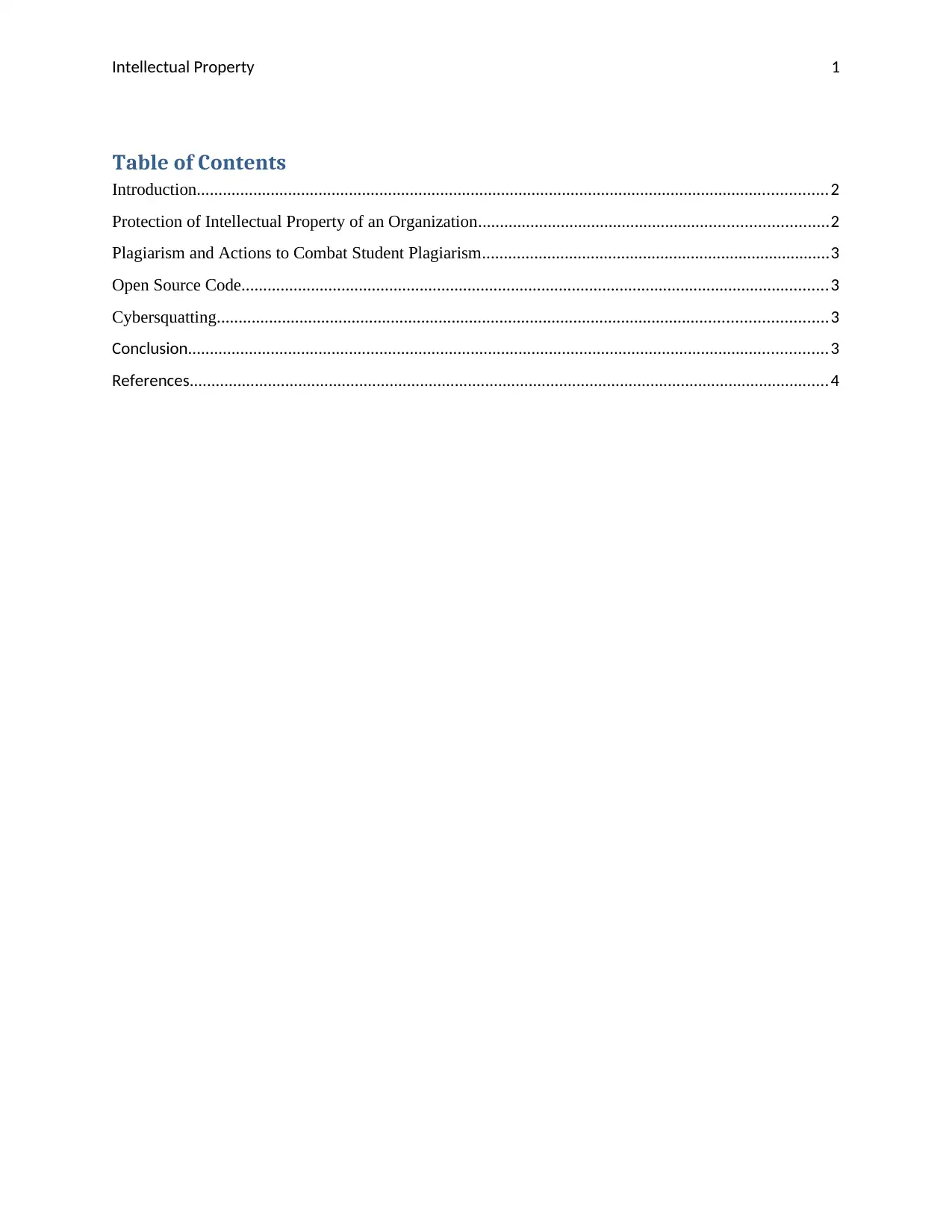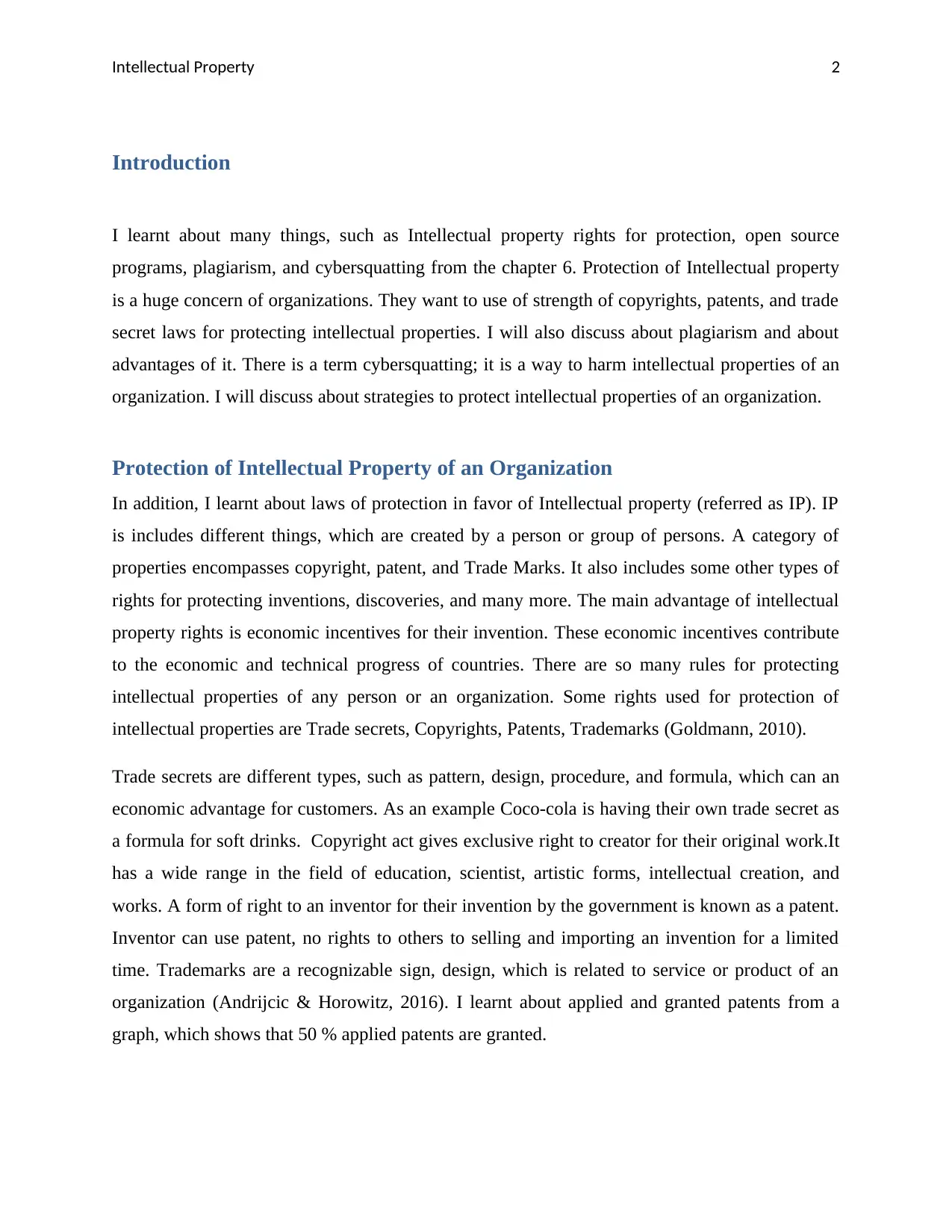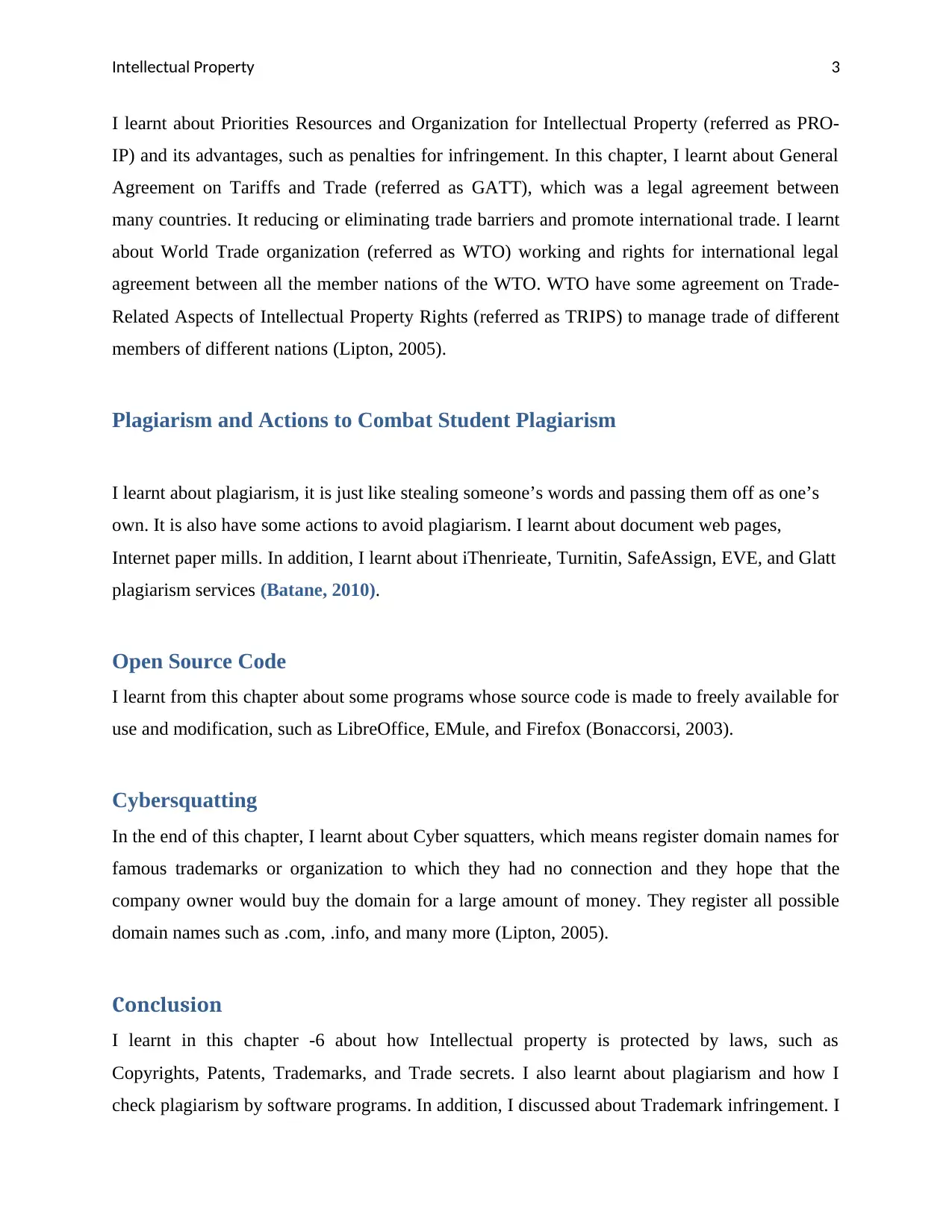ISY1000 Ethics in IT: A Reflective Journal on Intellectual Property
VerifiedAdded on 2023/06/07
|5
|999
|246
Journal and Reflective Writing
AI Summary
This reflective journal delves into various aspects of intellectual property as learned from Chapter 6, including the importance of protecting intellectual property rights through copyrights, patents, and trade secrets. It discusses plagiarism, methods to combat it, and the implications of open-source code. The journal also addresses cybersquatting and strategies to prevent it, referencing relevant articles and legal agreements like GATT and TRIPS. The reflection highlights the understanding of intellectual property laws and their impact on organizations and individuals, as well as the ethical considerations surrounding these issues within the field of Information Technology. The student also reflects on how this knowledge can be used in the future as an IT professional.

Running Head: INTELLECTUAL PROPERTY 0
Intellectual Property
Individual Assignment
Student Name
Intellectual Property
Individual Assignment
Student Name
Paraphrase This Document
Need a fresh take? Get an instant paraphrase of this document with our AI Paraphraser

Intellectual Property 1
Table of Contents
Introduction.................................................................................................................................................2
Protection of Intellectual Property of an Organization................................................................................2
Plagiarism and Actions to Combat Student Plagiarism................................................................................3
Open Source Code.......................................................................................................................................3
Cybersquatting............................................................................................................................................3
Conclusion...................................................................................................................................................3
References...................................................................................................................................................4
Table of Contents
Introduction.................................................................................................................................................2
Protection of Intellectual Property of an Organization................................................................................2
Plagiarism and Actions to Combat Student Plagiarism................................................................................3
Open Source Code.......................................................................................................................................3
Cybersquatting............................................................................................................................................3
Conclusion...................................................................................................................................................3
References...................................................................................................................................................4

Intellectual Property 2
Introduction
I learnt about many things, such as Intellectual property rights for protection, open source
programs, plagiarism, and cybersquatting from the chapter 6. Protection of Intellectual property
is a huge concern of organizations. They want to use of strength of copyrights, patents, and trade
secret laws for protecting intellectual properties. I will also discuss about plagiarism and about
advantages of it. There is a term cybersquatting; it is a way to harm intellectual properties of an
organization. I will discuss about strategies to protect intellectual properties of an organization.
Protection of Intellectual Property of an Organization
In addition, I learnt about laws of protection in favor of Intellectual property (referred as IP). IP
is includes different things, which are created by a person or group of persons. A category of
properties encompasses copyright, patent, and Trade Marks. It also includes some other types of
rights for protecting inventions, discoveries, and many more. The main advantage of intellectual
property rights is economic incentives for their invention. These economic incentives contribute
to the economic and technical progress of countries. There are so many rules for protecting
intellectual properties of any person or an organization. Some rights used for protection of
intellectual properties are Trade secrets, Copyrights, Patents, Trademarks (Goldmann, 2010).
Trade secrets are different types, such as pattern, design, procedure, and formula, which can an
economic advantage for customers. As an example Coco-cola is having their own trade secret as
a formula for soft drinks. Copyright act gives exclusive right to creator for their original work.It
has a wide range in the field of education, scientist, artistic forms, intellectual creation, and
works. A form of right to an inventor for their invention by the government is known as a patent.
Inventor can use patent, no rights to others to selling and importing an invention for a limited
time. Trademarks are a recognizable sign, design, which is related to service or product of an
organization (Andrijcic & Horowitz, 2016). I learnt about applied and granted patents from a
graph, which shows that 50 % applied patents are granted.
Introduction
I learnt about many things, such as Intellectual property rights for protection, open source
programs, plagiarism, and cybersquatting from the chapter 6. Protection of Intellectual property
is a huge concern of organizations. They want to use of strength of copyrights, patents, and trade
secret laws for protecting intellectual properties. I will also discuss about plagiarism and about
advantages of it. There is a term cybersquatting; it is a way to harm intellectual properties of an
organization. I will discuss about strategies to protect intellectual properties of an organization.
Protection of Intellectual Property of an Organization
In addition, I learnt about laws of protection in favor of Intellectual property (referred as IP). IP
is includes different things, which are created by a person or group of persons. A category of
properties encompasses copyright, patent, and Trade Marks. It also includes some other types of
rights for protecting inventions, discoveries, and many more. The main advantage of intellectual
property rights is economic incentives for their invention. These economic incentives contribute
to the economic and technical progress of countries. There are so many rules for protecting
intellectual properties of any person or an organization. Some rights used for protection of
intellectual properties are Trade secrets, Copyrights, Patents, Trademarks (Goldmann, 2010).
Trade secrets are different types, such as pattern, design, procedure, and formula, which can an
economic advantage for customers. As an example Coco-cola is having their own trade secret as
a formula for soft drinks. Copyright act gives exclusive right to creator for their original work.It
has a wide range in the field of education, scientist, artistic forms, intellectual creation, and
works. A form of right to an inventor for their invention by the government is known as a patent.
Inventor can use patent, no rights to others to selling and importing an invention for a limited
time. Trademarks are a recognizable sign, design, which is related to service or product of an
organization (Andrijcic & Horowitz, 2016). I learnt about applied and granted patents from a
graph, which shows that 50 % applied patents are granted.
⊘ This is a preview!⊘
Do you want full access?
Subscribe today to unlock all pages.

Trusted by 1+ million students worldwide

Intellectual Property 3
I learnt about Priorities Resources and Organization for Intellectual Property (referred as PRO-
IP) and its advantages, such as penalties for infringement. In this chapter, I learnt about General
Agreement on Tariffs and Trade (referred as GATT), which was a legal agreement between
many countries. It reducing or eliminating trade barriers and promote international trade. I learnt
about World Trade organization (referred as WTO) working and rights for international legal
agreement between all the member nations of the WTO. WTO have some agreement on Trade-
Related Aspects of Intellectual Property Rights (referred as TRIPS) to manage trade of different
members of different nations (Lipton, 2005).
Plagiarism and Actions to Combat Student Plagiarism
I learnt about plagiarism, it is just like stealing someone’s words and passing them off as one’s
own. It is also have some actions to avoid plagiarism. I learnt about document web pages,
Internet paper mills. In addition, I learnt about iThenrieate, Turnitin, SafeAssign, EVE, and Glatt
plagiarism services (Batane, 2010).
Open Source Code
I learnt from this chapter about some programs whose source code is made to freely available for
use and modification, such as LibreOffice, EMule, and Firefox (Bonaccorsi, 2003).
Cybersquatting
In the end of this chapter, I learnt about Cyber squatters, which means register domain names for
famous trademarks or organization to which they had no connection and they hope that the
company owner would buy the domain for a large amount of money. They register all possible
domain names such as .com, .info, and many more (Lipton, 2005).
Conclusion
I learnt in this chapter -6 about how Intellectual property is protected by laws, such as
Copyrights, Patents, Trademarks, and Trade secrets. I also learnt about plagiarism and how I
check plagiarism by software programs. In addition, I discussed about Trademark infringement. I
I learnt about Priorities Resources and Organization for Intellectual Property (referred as PRO-
IP) and its advantages, such as penalties for infringement. In this chapter, I learnt about General
Agreement on Tariffs and Trade (referred as GATT), which was a legal agreement between
many countries. It reducing or eliminating trade barriers and promote international trade. I learnt
about World Trade organization (referred as WTO) working and rights for international legal
agreement between all the member nations of the WTO. WTO have some agreement on Trade-
Related Aspects of Intellectual Property Rights (referred as TRIPS) to manage trade of different
members of different nations (Lipton, 2005).
Plagiarism and Actions to Combat Student Plagiarism
I learnt about plagiarism, it is just like stealing someone’s words and passing them off as one’s
own. It is also have some actions to avoid plagiarism. I learnt about document web pages,
Internet paper mills. In addition, I learnt about iThenrieate, Turnitin, SafeAssign, EVE, and Glatt
plagiarism services (Batane, 2010).
Open Source Code
I learnt from this chapter about some programs whose source code is made to freely available for
use and modification, such as LibreOffice, EMule, and Firefox (Bonaccorsi, 2003).
Cybersquatting
In the end of this chapter, I learnt about Cyber squatters, which means register domain names for
famous trademarks or organization to which they had no connection and they hope that the
company owner would buy the domain for a large amount of money. They register all possible
domain names such as .com, .info, and many more (Lipton, 2005).
Conclusion
I learnt in this chapter -6 about how Intellectual property is protected by laws, such as
Copyrights, Patents, Trademarks, and Trade secrets. I also learnt about plagiarism and how I
check plagiarism by software programs. In addition, I discussed about Trademark infringement. I
Paraphrase This Document
Need a fresh take? Get an instant paraphrase of this document with our AI Paraphraser

Intellectual Property 4
was discussed about some open source software. In the end of report, I discussed about
Cybersquatting and tactics to circumvent cybersquatting.
References
Andrijcic, E. & Horowitz, B., 2016. A Macro‐Economic Framework for Evaluation of Cyber
Security Risks Related to Protection of Intellectual Property. Risk analysis, 26(4), pp. 907-923.
Batane, T., 2010. Turning to Turnitin to fight plagiarism among university students. ournal of
Educational Technology & Society, 13(2), p. 1.
Bonaccorsi, A., 2003. Why Open Source software can succeed. Research policy, 32(7), pp.
1243-1258.
Goldmann, A. J., 2010. Protecting Intellectual Property. Journal of Internet Banking and
Commerce, 15(1), p. 1.
Lipton, J. D., 2005. Beyond Cybersquatting: Taking Domain Name Disputes Past Trademark
Policy. Wake Forest L. Rev., 40(1), p. 1361.
was discussed about some open source software. In the end of report, I discussed about
Cybersquatting and tactics to circumvent cybersquatting.
References
Andrijcic, E. & Horowitz, B., 2016. A Macro‐Economic Framework for Evaluation of Cyber
Security Risks Related to Protection of Intellectual Property. Risk analysis, 26(4), pp. 907-923.
Batane, T., 2010. Turning to Turnitin to fight plagiarism among university students. ournal of
Educational Technology & Society, 13(2), p. 1.
Bonaccorsi, A., 2003. Why Open Source software can succeed. Research policy, 32(7), pp.
1243-1258.
Goldmann, A. J., 2010. Protecting Intellectual Property. Journal of Internet Banking and
Commerce, 15(1), p. 1.
Lipton, J. D., 2005. Beyond Cybersquatting: Taking Domain Name Disputes Past Trademark
Policy. Wake Forest L. Rev., 40(1), p. 1361.
1 out of 5
Related Documents
Your All-in-One AI-Powered Toolkit for Academic Success.
+13062052269
info@desklib.com
Available 24*7 on WhatsApp / Email
![[object Object]](/_next/static/media/star-bottom.7253800d.svg)
Unlock your academic potential
Copyright © 2020–2025 A2Z Services. All Rights Reserved. Developed and managed by ZUCOL.




